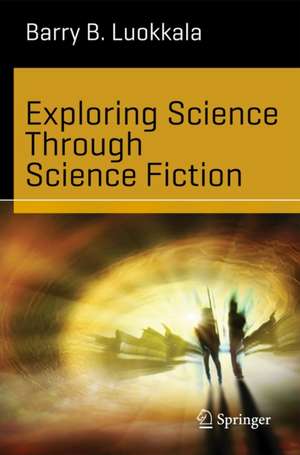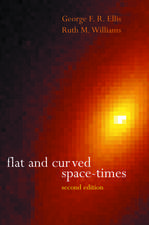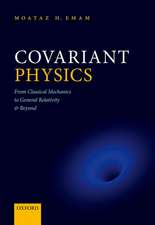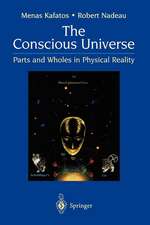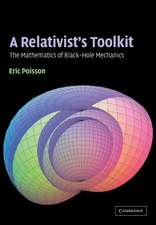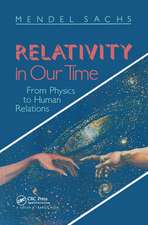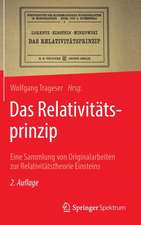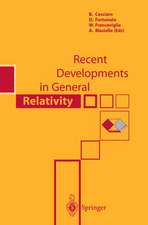Exploring Science Through Science Fiction: Science and Fiction
Autor Barry B. Luokkalaen Limba Engleză Paperback – 23 oct 2013
| Toate formatele și edițiile | Preț | Express |
|---|---|---|
| Paperback (2) | 149.48 lei 22-36 zile | +15.33 lei 6-12 zile |
| Springer – 23 oct 2013 | 149.48 lei 22-36 zile | +15.33 lei 6-12 zile |
| Springer International Publishing – 13 noi 2019 | 216.60 lei 22-36 zile | +28.53 lei 6-12 zile |
Din seria Science and Fiction
-
 Preț: 129.05 lei
Preț: 129.05 lei -
 Preț: 104.10 lei
Preț: 104.10 lei -
 Preț: 103.05 lei
Preț: 103.05 lei -
 Preț: 104.92 lei
Preț: 104.92 lei - 5%
 Preț: 102.99 lei
Preț: 102.99 lei -
 Preț: 105.96 lei
Preț: 105.96 lei -
 Preț: 212.63 lei
Preț: 212.63 lei -
 Preț: 162.50 lei
Preț: 162.50 lei -
 Preț: 146.18 lei
Preț: 146.18 lei - 5%
 Preț: 218.95 lei
Preț: 218.95 lei -
 Preț: 128.64 lei
Preț: 128.64 lei -
 Preț: 150.92 lei
Preț: 150.92 lei -
 Preț: 115.46 lei
Preț: 115.46 lei -
 Preț: 111.50 lei
Preț: 111.50 lei -
 Preț: 101.01 lei
Preț: 101.01 lei -
 Preț: 103.91 lei
Preț: 103.91 lei -
 Preț: 337.51 lei
Preț: 337.51 lei -
 Preț: 131.12 lei
Preț: 131.12 lei -
 Preț: 141.41 lei
Preț: 141.41 lei -
 Preț: 484.79 lei
Preț: 484.79 lei -
 Preț: 182.09 lei
Preț: 182.09 lei -
 Preț: 106.14 lei
Preț: 106.14 lei -
 Preț: 147.23 lei
Preț: 147.23 lei -
 Preț: 183.84 lei
Preț: 183.84 lei -
 Preț: 109.86 lei
Preț: 109.86 lei -
 Preț: 207.39 lei
Preț: 207.39 lei -
 Preț: 72.68 lei
Preț: 72.68 lei -
 Preț: 148.46 lei
Preț: 148.46 lei -
 Preț: 154.46 lei
Preț: 154.46 lei -
 Preț: 146.58 lei
Preț: 146.58 lei -
 Preț: 179.68 lei
Preț: 179.68 lei -
 Preț: 184.72 lei
Preț: 184.72 lei -
 Preț: 133.99 lei
Preț: 133.99 lei -
 Preț: 149.45 lei
Preț: 149.45 lei -
 Preț: 128.86 lei
Preț: 128.86 lei -
 Preț: 146.36 lei
Preț: 146.36 lei -
 Preț: 152.76 lei
Preț: 152.76 lei - 20%
 Preț: 225.94 lei
Preț: 225.94 lei -
 Preț: 214.22 lei
Preț: 214.22 lei -
 Preț: 190.49 lei
Preț: 190.49 lei -
 Preț: 168.11 lei
Preț: 168.11 lei -
 Preț: 174.83 lei
Preț: 174.83 lei -
 Preț: 111.33 lei
Preț: 111.33 lei -
 Preț: 183.23 lei
Preț: 183.23 lei -
 Preț: 147.28 lei
Preț: 147.28 lei -
 Preț: 173.75 lei
Preț: 173.75 lei
Preț: 149.48 lei
Nou
Puncte Express: 224
Preț estimativ în valută:
28.60€ • 29.94$ • 23.81£
28.60€ • 29.94$ • 23.81£
Carte disponibilă
Livrare economică 10-24 martie
Livrare express 22-28 februarie pentru 25.32 lei
Preluare comenzi: 021 569.72.76
Specificații
ISBN-13: 9781461478904
ISBN-10: 1461478901
Pagini: 210
Ilustrații: 8 schwarz-weiße und 19 farbige Abbildungen
Dimensiuni: 155 x 235 x 15 mm
Greutate: 0.37 kg
Ediția:2014
Editura: Springer
Colecția Springer
Seria Science and Fiction
Locul publicării:New York, NY, United States
ISBN-10: 1461478901
Pagini: 210
Ilustrații: 8 schwarz-weiße und 19 farbige Abbildungen
Dimensiuni: 155 x 235 x 15 mm
Greutate: 0.37 kg
Ediția:2014
Editura: Springer
Colecția Springer
Seria Science and Fiction
Locul publicării:New York, NY, United States
Public țintă
Lower undergraduateRecenzii
“Exploring Science Through Science Fiction. A spark from a class at Carnegie Mellon gave birth to this book of great depth and breadth in the world of science and various fiction surrounding it. It offers a great look into the known and unknown and is sure to make you think.” (Christian Pavlovich, Film Matters, Vol. 9 (1), 2018)
“Barry B. Luokkala’s Exploring Science Through Science Fiction offers a wide-ranging treatment of fundamental scientific questions and concepts as dramatized in science fiction. Designed for an undergraduate science course, this textbook addresses the varying degree of plausibility inherent to many popular science fiction constructs … . Exploring Science through Science Fiction strikes a delicate compromise, introducing readers to the fantastical side of science without being completely overwhelming.” (Jen Jenkins, Journal of Science Fiction, Vol. 2 (1), September, 2017)
“Exploring Science through Science Fiction fits into a lineage of works that use science fiction as a starting point for science education. … The book is very clear and well written. … the book is a good text for an optional one-semester undergraduate course, but it can also be used as a source of ideas for sci-fi illustrations of particular points in any core science course, even at high school level. … I highly recommend this book.” (Jerzy Brzozowski, Science and Education, Vol. 25, 2016)
“Luokkala has recognized the usefulness of this bridging of the arts and sciences in the classroom, and his textbook … comes out of more than a decade of teaching an undergraduate course on this topic. … it provides an engaging introduction to scientific thinking. The proposed discussion topics may indeed work best in a mixed classroom, in which students will be able to learn how views on the topic under discussion may differ between scientists and non-scientists.” (Kanta Dihal, Foundation, Vol. 122, 2015)
“The author presents many good discussion and exploration topics, as well as back-of-the-envelope-type estimation problems. The references include DVD release and scene number information, making the chapter and end-of-book bibliographies highly valuable to instructors interested in bringing such subject material into their classroom. Summing Up: Recommended. All undergraduate students, faculty, and general readers.” (S. A. Curtis, Choice, Vol. 51 (10), June, 2014)
“Exploring Science Through Science Fiction is organized into seven chapters centered on common themes in science fiction film and literature … . this book is an engaging and readable text. … The textbook has the ability to spark in its readers an interest in and appreciation for science and technology. Luokkala provides ample resources in the appendices for interested readers to continue their own investigations.” (Emily Margolis, Quest The history of Spaceflight, Vol. 21 (3), 2014)
Notă biografică
Barry
Luokkala
is
a
teaching
professor
and
director
of
undergraduate
laboratories
in
the
department
of
physics
at
Carnegie
Mellon
University.
He
received
his
BS
and
MS
degrees
in
physics
at
the
University
of
Pittsburgh,
where
he
did
experimental
research
in
the
physics
and
chemistry
of
the
ionosphere.
He
received
his
PhD
in
experimental
condensed
matter
physics
at
Carnegie
Mellon
University.
He
has
also
served
as
program
director
for
the
Pennsylvania
Governor’s
School
for
the
sciences
and
has
been
a
science
consultant
for
the
Sloan
Foundation
Screenplay
Competition
in
Carnegie
Mellon’s
School
of
Drama.
Textul de pe ultima copertă
How
does
Einstein’s
description
of
space
and
time
compare
withDr.
Who?
Can
James
Bond
really
escape
from
an
armor-plated
railroad
car
by
cutting
through
the
floor
with
a
laser
concealed
in
a
wristwatch?
What
would
it
take
to
create
a
fully-intelligent
android,
such
asStar
Trek’s
Commander
Data?
How
might
we
discover
intelligent
civilizations
on
other
planets
in
the
galaxy?
Is
human
teleportation
possible?
Will
our
technological
society
ever
reach
the
point
at
which
it
becomes
lawful
to
discriminate
on
the
basis
of
genetic
information,
as
in
the
movieGATTACA?
Exploring Science Through Science Fictionaddresses these and other interesting questions, using science fiction as a springboard for discussing fundamental science concepts and cutting-edge science research. The book is designed as a primary text for a college-level course which should appeal to students in the fine arts and humanities as well as to science and engineering students. It includes references to original research papers, landmark scientific publications and technical documents, as well as a broad range of science literature at a more popular level. With over 180 references to specific scenes in 130 sci-fi movies and TV episodes, spanning over 100 years of cinematic history, it should be an enjoyable read for anyone with an interest in science and science fiction.
Exploring Science Through Science Fictionaddresses these and other interesting questions, using science fiction as a springboard for discussing fundamental science concepts and cutting-edge science research. The book is designed as a primary text for a college-level course which should appeal to students in the fine arts and humanities as well as to science and engineering students. It includes references to original research papers, landmark scientific publications and technical documents, as well as a broad range of science literature at a more popular level. With over 180 references to specific scenes in 130 sci-fi movies and TV episodes, spanning over 100 years of cinematic history, it should be an enjoyable read for anyone with an interest in science and science fiction.
Cuprins
1 Introduction: Discerning the Real, the Possible and the Impossible.- 2 What is the Nature of Space and Time? (the physics of space travel and time travel).- 3 What is the Universe Made of? (matter, energy and interactions).- 4 Can a Machine Become Self-Aware? (the sciences of computing and cognition).- 5 Are We Alone in the Universe? (the search for extraterrestrial intelligence).- 6 What does it Mean to be Human? (biological sciences, biotechnology and other considerations).- 7 How do We Solve Our Problems? (science, technology and society).- 8 What Lies Ahead? (the future of our technological society).- Appendix A: Catalog of Movies Cited.- Appendix B: Catalog of Television Series Episodes Cited.- Appendix C: Catalog of YouTube Videos Cited.- Appendix D: List of Works Cited.- Appendix E: Solutions to Estimation Problems.- Index.
Caracteristici
Extensively updated with the latest breakthroughs and films Explores fundamental scientific concepts while drawing examples from popular science fiction films and television Appendices of films, TV episodes, YouTube videos, and literature facilitate the use of fun examples in the classroom Features numerical examples and their solutions
